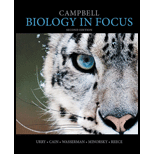
Concept explainers
The light reactions of photosynthesis supply the Calvin cycle with
- A. light energy.
- B. CO2 and ATP.
- C. O2 and NADPH.
- D. ATP and NADPH.
Introduction:
The reaction directly dependent on light are called light reaction and occurs in the grana and stromal thylakoid of chloroplast. The light independent reaction is called the dark reaction. It occurs in the stroma of chloroplast.
Answer to Problem 1TYU
Correct answer:
Light reaction uses the sunlight to split water and pass electron through the photosystems to make energy for the production of sugar by the dark reaction. Therefore, option (D) is correct.
Explanation of Solution
Reason for the correct statement:
Thylakoid present in the chloroplast has two types of photosystems. These help in the conversion of solar energy into the usable chemical energy. Photosystem I produces ATP only and photosystem II produces ATP and NADPH. These chemical forms of energy are used in Calvin cycle to make sugar.
Option (D) is given as “ATP and NADPH”.
“The light reaction of photosynthesis supply the Calvin cycle with ATP and NADPH”, it is the right answer.
Hence, option (D) is correct.
Reasons for the incorrect statements:
Option (A) is given as “light energy”.
The light reaction requires light energy to produce, ATP and NADPH molecules. So, it is a wrong answer.
Option (B) is given as “
Carbon di oxide is supplied to the calvin cycle but not the ATP. So, it is a wrong answer.
Option (C) is given as “
NADPH and oxygen are given by the light reaction but oxygen is not supplied to the Calvin cycle, it has no use in it. So, it is a wrong answer.
Hence, options (A) (B) and (C) are incorrect.
The light reaction provides the dark reaction, Calvin cycle, with ATP and NADPH for making organic products.
Want to see more full solutions like this?
Chapter 8 Solutions
Campbell Biology in Focus (2nd Edition)
Additional Science Textbook Solutions
Chemistry: The Central Science (14th Edition)
Biology: Life on Earth with Physiology (11th Edition)
College Physics: A Strategic Approach (3rd Edition)
Physics for Scientists and Engineers: A Strategic Approach, Vol. 1 (Chs 1-21) (4th Edition)
Human Biology: Concepts and Current Issues (8th Edition)
Human Anatomy & Physiology (2nd Edition)
- What symbolic and cultural behaviors are evident in the archaeological record and associated with Neandertals and anatomically modern humans in Europe beginning around 35,000 yBP (during the Upper Paleolithic)?arrow_forwardDescribe three cranial and postcranial features of Neanderthals skeletons that are likely adaptation to the cold climates of Upper Pleistocene Europe and explain how they are adaptations to a cold climate.arrow_forwardBiology Questionarrow_forward
- ✓ Details Draw a protein that is embedded in a membrane (a transmembrane protein), label the lipid bilayer and the protein. Identify the areas of the lipid bilayer that are hydrophobic and hydrophilic. Draw a membrane with two transporters: a proton pump transporter that uses ATP to generate a proton gradient, and a second transporter that moves glucose by secondary active transport (cartoon-like is ok). It will be important to show protons moving in the correct direction, and that the transporter that is powered by secondary active transport is logically related to the proton pump.arrow_forwarddrawing chemical structure of ATP. please draw in and label whats asked. Thank you.arrow_forwardOutline the negative feedback loop that allows us to maintain a healthy water concentration in our blood. You may use diagram if you wisharrow_forward
- Give examples of fat soluble and non-fat soluble hormonesarrow_forwardJust click view full document and register so you can see the whole document. how do i access this. following from the previous question; https://www.bartleby.com/questions-and-answers/hi-hi-with-this-unit-assessment-psy4406-tp4-report-assessment-material-case-stydu-ms-alecia-moore.-o/5e09906a-5101-4297-a8f7-49449b0bb5a7. on Google this image comes up and i have signed/ payed for the service and unable to access the full document. are you able to copy and past to this response. please see the screenshot from google page. unfortunality its not allowing me attch the image can you please show me the mathmetic calculation/ workout for the reult sectionarrow_forwardIn tabular form, differentiate between reversible and irreversible cell injury.arrow_forward
 Biology (MindTap Course List)BiologyISBN:9781337392938Author:Eldra Solomon, Charles Martin, Diana W. Martin, Linda R. BergPublisher:Cengage Learning
Biology (MindTap Course List)BiologyISBN:9781337392938Author:Eldra Solomon, Charles Martin, Diana W. Martin, Linda R. BergPublisher:Cengage Learning
 Concepts of BiologyBiologyISBN:9781938168116Author:Samantha Fowler, Rebecca Roush, James WisePublisher:OpenStax College
Concepts of BiologyBiologyISBN:9781938168116Author:Samantha Fowler, Rebecca Roush, James WisePublisher:OpenStax College Biology: The Dynamic Science (MindTap Course List)BiologyISBN:9781305389892Author:Peter J. Russell, Paul E. Hertz, Beverly McMillanPublisher:Cengage Learning
Biology: The Dynamic Science (MindTap Course List)BiologyISBN:9781305389892Author:Peter J. Russell, Paul E. Hertz, Beverly McMillanPublisher:Cengage Learning Biology Today and Tomorrow without Physiology (Mi...BiologyISBN:9781305117396Author:Cecie Starr, Christine Evers, Lisa StarrPublisher:Cengage Learning
Biology Today and Tomorrow without Physiology (Mi...BiologyISBN:9781305117396Author:Cecie Starr, Christine Evers, Lisa StarrPublisher:Cengage Learning Biology 2eBiologyISBN:9781947172517Author:Matthew Douglas, Jung Choi, Mary Ann ClarkPublisher:OpenStax
Biology 2eBiologyISBN:9781947172517Author:Matthew Douglas, Jung Choi, Mary Ann ClarkPublisher:OpenStax





